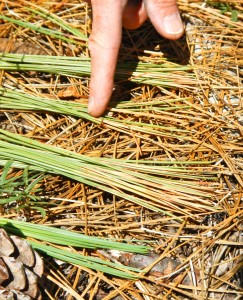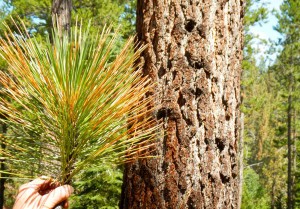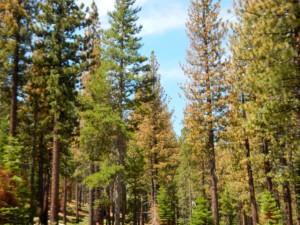Drought impacting Tahoe’s forest health
By Kathryn Reed
MEYERS – The tiny moths that are turning a large swath of the South Shore orange are out mating so there will presumably be more organisms to wreak havoc.
The needle miner is a micro moth that lives about a year, but can do tremendous harm in its short lifespan. They live in the needles of pine trees.
Soon they will lay eggs on the current growth of green needles. If they continue to populate, their work will turn up in a year.
They have taken over about a 40-acre area near Pioneer Trail and Highway 50 in Meyers. The exact acreage will be noted in September when the U.S. Forest Service takes its annual aerial photographs of the Lake Tahoe Basin.

Forest pathologist Martin MacKenzie shows needles from 2011, top, 2012, 2013 and 2014. The moth has not landed on the 2014 needles — yet.
“They are native and have been here all along,” Martin MacKenzie, a forest pathologist, told Lake Tahoe News. “They are species specific. This one is so little-known it doesn’t have a name.”
MacKenzie works out of the Stanislaus National Forest, but was in the basin last week surveying the local damage caused by the needle miner to the Jeffery pines.
Taking a small branch off an infected tree, MacKenzie surveys the growth rings. Removing needles from each section it’s easy to see the increased damage that has been done by the moth since 2011.
It’s not until every needle is red that the tree is dead.
The needle miners that attack lodgepoles are more common. The only Jeffery stands the needle miners are known to have infested are the ones in Meyers, the Al Tahoe neighborhood of South Lake Tahoe, and eight miles along Highway 395 in the Inyo National Forest.
“I think the recent climate phenomenon has allowed this moth to get out of whack,” MacKenzie said.
The moths’ natural predator is a wasp. What happened to the wasp is a mystery. The wasp will lay its egg on the caterpillar and eat inside out so a moth never comes to life. That process is what is missing.
“The natural balance is out of control,” MacKenzie said.
While MacKenzie and Rita Mustatia, forester with the Lake Tahoe Basin Management Unit, don’t believe the moth will kill the trees, prolonged destruction of the branches combined with the drought could weaken the trees. For now, though, it is more of an aesthetic issue. The trees look like they are dying.
That is one reason why Forest Service officials don’t want people running to a tree service to have them felled. Odds are the trees will survive.
Mustatia points to thinning tree stands as one way to help the longevity of the pines. Trees grow faster with more sunlight and when they don’t have to compete for water. A healthier tree is going to withstand the ravages of the moth for a longer period of time.

